One of the best ways to make an imaginative world feel real is to ground it with connections to planet earth.
Adding real life elements to a creation doesn’t mean it has to be mundane, however. Quite the opposite–the world we know can often be even more fantastic and beautiful than the worlds we imagine.
In the first part of my series on this subject I introduced some of the incredible natural wonders visible at the fringes of our planet, where humans rarely venture. In this post I will turn my attention to the incredible forces that shape our world, and the raw power and delicate natural artwork that results.
The ancient religion of Zoroastrianism divided these formative forces into earth, water, air, and fire. Although not exactly an accurate periodic table, these four “elements” inspired thousands of years of thinkers and artists…not to mention the odd 70’s band!
These forces interact all around us to create an astonishing variety of natural phenomena. Allow me to share some unusual and stunning examples. Perhaps Mother Nature’s creativity will inspire your own!
Earth
Most of us think we’re pretty comfortable with the good old earth “element.” As animals go, humans aren’t spectacular swimmers or fliers, so we spend a lot of time on the ground. Familiarity breeds contempt, as they say, and so we call a humdrum, dull, unintelligent person “dumb as dirt,” or perhaps “as a box of rocks.”
Any of my geologist or paleontologist friends will tell you that no comparison could be less accurate. The ground below us is capable of incredible beauty and variety, often forming natural sculptures that defy belief.
Karst Topography
I’ve called this series of posts “Fantasy Landscapes that Actually Exist.” This was literally the case for the dramatic karst topography of Asia. For a long time when westerners saw landscape paintings like this…
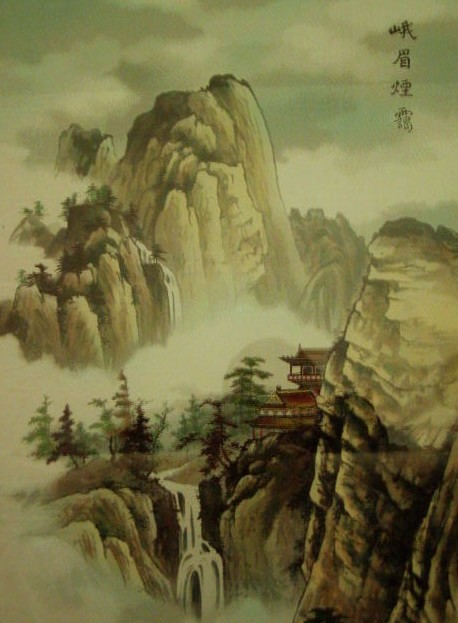
Image from: siue.edu.
…they assumed the depictions were heavily romanticized fantasy images, where the artist had abstracted the idea of a mountain into an unrealistically tall and pointed spire.
When westerners got a look at the mountains of southern China, however, they discovered that the paintings had been all too literal.

Image from: Avax.news.
Karst topography occurs when a soft underground layer of rock (often limestone or dolomite) is eroded by subterranean water.
This is actually a pretty common occurrence, and is how most caves are formed (click here to check out some awesome caves, by the way). When the ground above a cave system collapses we’d call it a sinkhole. Add a lot more water and time though, and the sinkholes join together until little limestone remains.
The residual landscape may form tall towers, as seen above, or even sharp pinnacles, as in the famous “Stone forest,” where thousands of rocky spires shoot up to 98 meters into the sky!

Image from: Tripping.com.
Karst topography isn’t a fantasy, but it has inspired plenty of them. You’ll might remember seeing similar landscapes in the movie Avatar…or even in our own Legend of Zelda Cosplay Project.

Zhangye Danxia Landform Geological Park
“Sure, there are short rocks, tall rocks, fat rocks, and skinny rocks,” you might think, “but there’s one thing they all have in common. They’re pretty much brown or grey…or reddish on a really creative day.”
Anybody who’s been to a jewelry store and seen emeralds, rubies, opals, sapphires, lapis lazuli, malachite, (I could go on all day), etc. will know that mother earth accessorizes in colors for every season. Even so, it’s not just little gemstones that get to branch out.

Image from: Feel the Planet.
In China again is an incredible landscape so colorful that you’d be forgiven for thinking it was the abandoned set of a failed live action My Little Pony film.
As with the karst seen above, this rocky rainbow is actually formed through interaction with water and air.
Everyone knows that if you don’t protect your car from the elements with paint or wax, it’s going to oxidize (rust). The “oxi-” in “oxidize” comes from Oxygen, which alters the chemical composition of things by stealing their hydrogen molecules.

Image from: Feel the Planet.
When a rock forms with oxygen around it and iron inside it, the iron will oxidize and turn the rock red. If there’s no oxygen around then an opposite process called “reduction” will occur, giving the iron extra hydrogen and turning it black.
These same two processes, oxidation and reduction, can create all kinds of colors depending on the mineral they affect. The Statue of Liberty is a good example of Oxygen turning copper green!
In the Zhangye Danxia landform, each layer of rock has its own unique minerals, and these are either oxidized or reduced depending on the environment when they were formed.
Sorry about all the geeking out. As a former geologist I may get a little carried away where rocks are concerned. The moral of the story is that stone can have an incredible spectrum of colors…and once again China wears it best!

Balancing Rocks
Ok, so rocks can be colorful, but they’re still not that interesting, right? I mean, they just sit there in the ground.
Maybe so, maybe not. There may not be any flying rocks, but the world is full of examples of stones so precariously perched that they seem almost to defy physics.
You’ve probably heard of the massive “Balanced Rock” from Colorado’s “Garden of the Gods”…
Image from: Bamawester.
…but have you heard of the equally creatively named “balancing rock” in Nova Scotia?

Image from: Amandamackay.com.
Or what about North Yorkshire’s 200-ton “Idol rock?”

Image from: Wikimedia Commons.
There are numerous examples around the world of stones like these which have naturally settled over thousands of years into a tranquil yet delicate balance inimitable by human hands.
Pumice rafts
While I’m on the subject of rocks which appear to float, why not mention some that actually do?
In fantasy and sci-fi stories a floating island is always makes for a convenient plot twist, but although floating vegetation rafts are fairly common in real life, you usually don’t count on rocks to float.
Image from: Avatar Wiki.
Unless, of course, you are scrubbing your toilet. If you fumble and let go of your pumice stone, you expect it to float up to the top of the water rather than forcing you to chase it deeper into the plumbing than you want to go…
Pumice is a volcanic rock that forms when lava is belched out of the earth at high speed. As it sprays through the air the stone cools rapidly and has no chance to release the gasses trapped inside it. The resulting rock is porous and lighter than water!
When a volcano erupts underwater large amounts of pumice can be expelled straight into the ocean and voila! Instant island!

Image from: Oregonstate.edu.
Pumice rafts like these can cover hundreds of square miles, but unfortunately they are usually only a few inches thick and don’t support weight well.
If the eruption is big enough, however, things might be different. The incredible Krakatoa volcanic explosion of 1883 was so powerful that it launched pumice 34 miles into the air, and some of it didn’t land for up to 10 days! (Maybe rocks do fly…) The rafts created by this unreal eruption were so thick that seamen reported they could walk on them, and even said they saw tree trunks supported by the floating rock.
Is this just another sailors’ fish story? Pray that you never find out firsthand…
Water
We’ve followed rock and earth from mountain peak all the way out the middle of the ocean, so it might be a good time to discuss our next “element:” Water.
Think you know water? You drink it, splash in it, and surf in it, but water does one other incredible thing that allows it to break all kinds of rules–it freezes, and unlike most cold things, when it freezes it floats.
Icebergs
When it comes to floating islands, none come in a more fantastic variety of shapes and sizes than icebergs.

Icebergs not only look epic…they have a pretty awesome origin story as well.
They start as snow–trillions of gorgeous, unique six-sided crystals falling out of the sky until the entire landscape is changed.
Once enough unassuming snowflakes (like, a few hundred meters of them) pile up, however, their character suddenly changes! Under the immense pressure of its own weight the ice will recrystalize into a mobile form and start to flow–tearing up boulders and chewing up mountains in a raging icy river of death!

When a glacier meets the sea it breaks apart and “calves” tens of thousands of children into the sea, and there, amidst wind and wave, an astonishing variety of shapes can be found.

Image from: iCool.
Some look like fire…

Image from: iCool.
Some seem to defy gravity…

Image from: Caesartort.wordpress.com.
And some keep the crystalline beauty of their snowy origins.

Image from: Reddit.
These floating works of art are all the more alluring because they are ephemeral–always melting and changing shape–and because they’re more than a little dangerous to lovestruck seafarers!
Frozen Bubbles
Unless you live in the arctic (or take a trip on the Titanic) you may not get too many up-close views of icebergs, but if you’re anywhere cold enough for a winter freeze, you may find some astounding beauty in your local lake.
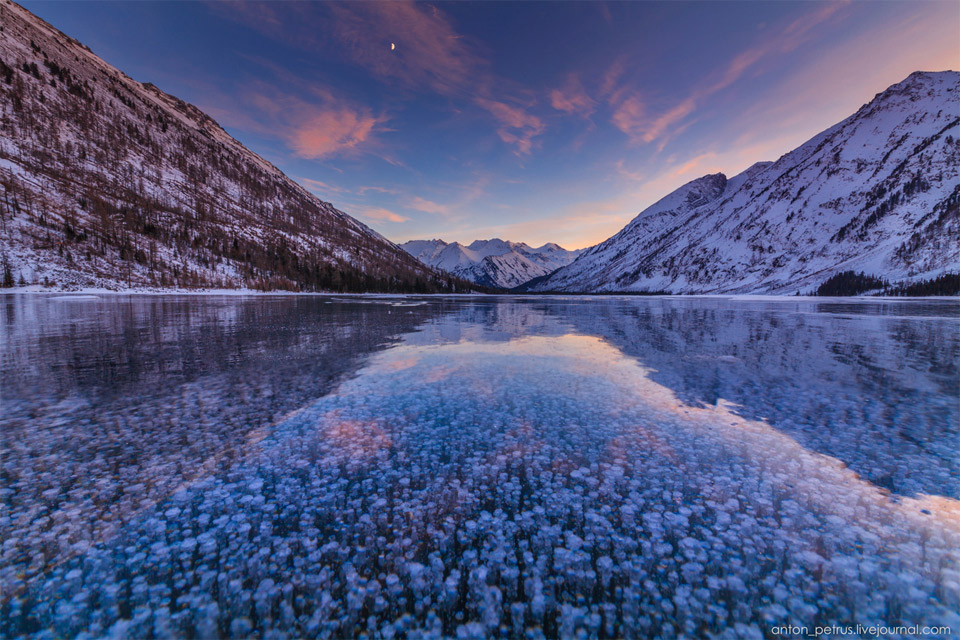
Image from: Onebigphoto.com.
Because ice floats, when a freshwater lake freezes the plants and fish at the bottom aren’t frosted over or crushed (thank goodness, or else they would all be wiped out every year!).
As the plants continue their underwater lives, they expel oxygen as usual, but the bubbles get trapped by the sheet of ice at the surface.
If the weather stays cold, then the ice will gradually get thicker and thicker, trapping columns of bubbles in a surreal state of “frozen” animation!
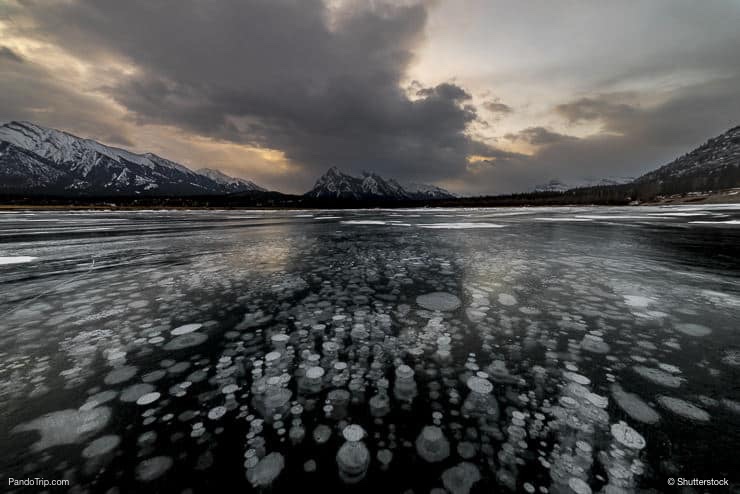
Image from: Pandotrip.com.
Brinicles
I mentioned just above that winter doesn’t kill underwater life because ice floats.
That’s…mostly true.
In the coldest oceans of the world stalactites of ice (called “brinicles“) can venture down from the surface of the water and make havoc on the sea bed.
The video above does a great job explaining how it happens, but in short, sea water loses its salt as it freezes. The extra salt forms a brine which can get supercooled (salt lowers the freezing temperature), and super dense. As the chilly brine falls through the water it freezes everything it touches until finally it reaches the ocean floor and terrorizes slow moving sea life.

Image from: Keajaibannya.
The “element” of water might seem all too familiar to most of us, but floating islands, rivers of ice, and subaqueous stalactites prove it has plenty of tricks up its sleeve.
Wind
If you’re a fan of Avatar, the Last Airbender, then you might be predisposed to think of air as the friendliest and most serene of elements. Since it’s invisible, Air can be difficult to notice sometimes, but when wind interacts with water, earth, or fire, some incredible things start happening.
Ice storms
Mix air and water at the right temperature and you may get the chance to see wind on display in solid form!
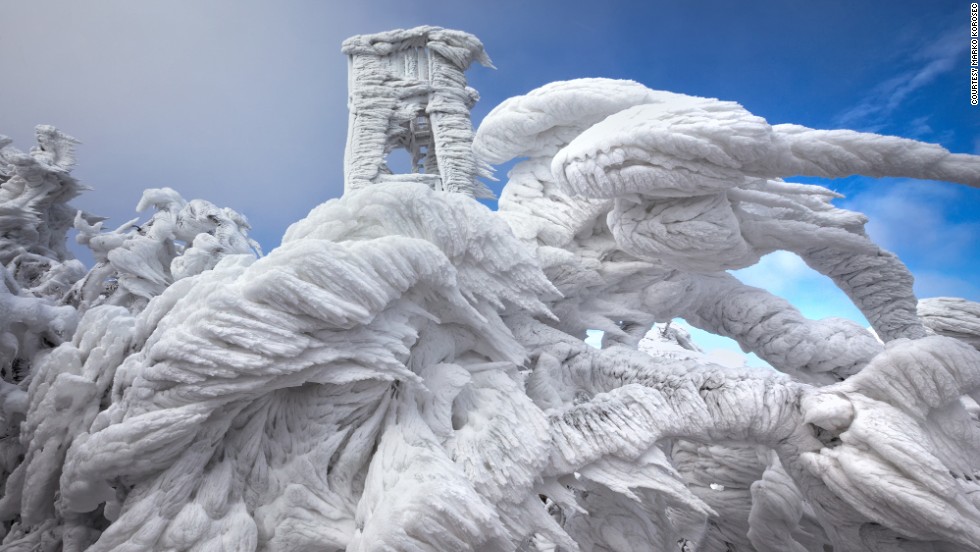
Image from: Fragrantica.com.
An ice storm occurs when a winter “inversion” (warm air up high, cold air close to the ground) causes liquid rain to fall on a frigid landscape and freeze on contact.

Image from: Bridoz.com.
Add a stiff wind to the mix and you get ice like you’ve never seen it before!
Sand/dust storms
If you’ve watched any movie set in a desert, then you’ve probably seen the most infamous team-up of earth and sky: the sandstorm.

Image from: Vizrt.com.
Storms like these are frightening and make great cinema, but when the sand is finer and the air is calmer a much more eerie effect is achieved.
On the morning of September 25th 2009, the citizens of Sydney, Australia awoke to discover that red, iron-rich dust blown from inland had turned their coastal city into a martian landscape.
Throw enough of the right particles into the air, and you could theoretically turn the sky almost any color you wanted!
Fire Whirls
Perhaps the most dramatic thing you could hurl into the air, however, is fire.
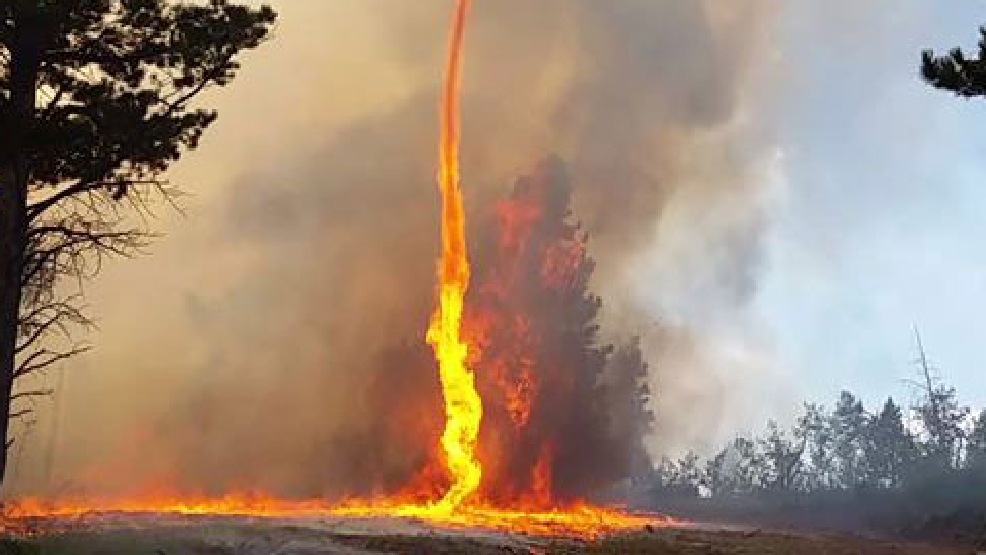
Image from: Kval.com.
In this natural phenomenon fire on the ground heats the air above it, causing it to rise in a column. Air from the surrounding area is sucked into the vacuum, is heated, and joins the column. Like water running out of a bathtub drain (except upside down), the air can begin to swirl until a “pillar of fire” of biblical proportions is created!
Natural fire whirls (or “firenadoes,” if you want to sound like a B movie) are rarely caught in more photographic detail than seen above, because they can be quite dangerous and hopefully only firefighters are present to document them.
Thankfully, it’s fairly straightforward to create a mini fire whirl under controlled circumstances. When this is done it can give us a rare glimpse into the exquisite beauty of this violent spectacle.
Fire
While I’m on the subject of fire, it’s time to explore this last, and least familiar, of elements.
Mount Nyiragongo Lava Lake
Most of us have had some imaginative idea of what lava is since we were kids and jumped between couches lest we be incinerated in an imaginary lake of molten carpet.
The peculiar physics of these childhood games seems to influence the way we see molten rock as adults. Seething rivers and seas of lava show up constantly in films, but although on the one hand it appears to melt anything it touches, if people have so much as a piece of paper between themselves and the burning liquid, somehow they seem to be fine.

Lava lakes do exist outside the realm of TV tropes, however. Or perhaps I should say a lava lake exists, because there is only one permanent pool of lava in the world, at the summit of Mount Nyiragongo.

Image from: National Geographic.
The world may have only one real lava lake, but it’s everything you could wish for. It’s inside one of the world’s most dangerous volcanoes…nestled in Africa’s Virunga jungle…which is populated by the largest gorillas in the world.

Image from: Boston.com.
What are your chances of surviving, riding on a rock across this molten pool? Not good, my geologist friends tell me. Remember that hot air rises. Apparently you’re pretty safe if you’re off to the sides of a lava flow, but if you’re above it then you’re toast…literally.
Yellowstone Grand Prismatic Spring
Life may not do too hot (pun totally intended) when magma bubbles up to the earth’s surface, but when the heat is moved a little farther underground a much more survivable form of “lava lake” can occur.

Image from: Wikimedia Commons.
Yellowstone National Park sits atop a restlessly slumbering supervolcano, which heats underground water and forms some of the most spectacular hot springs on earth.
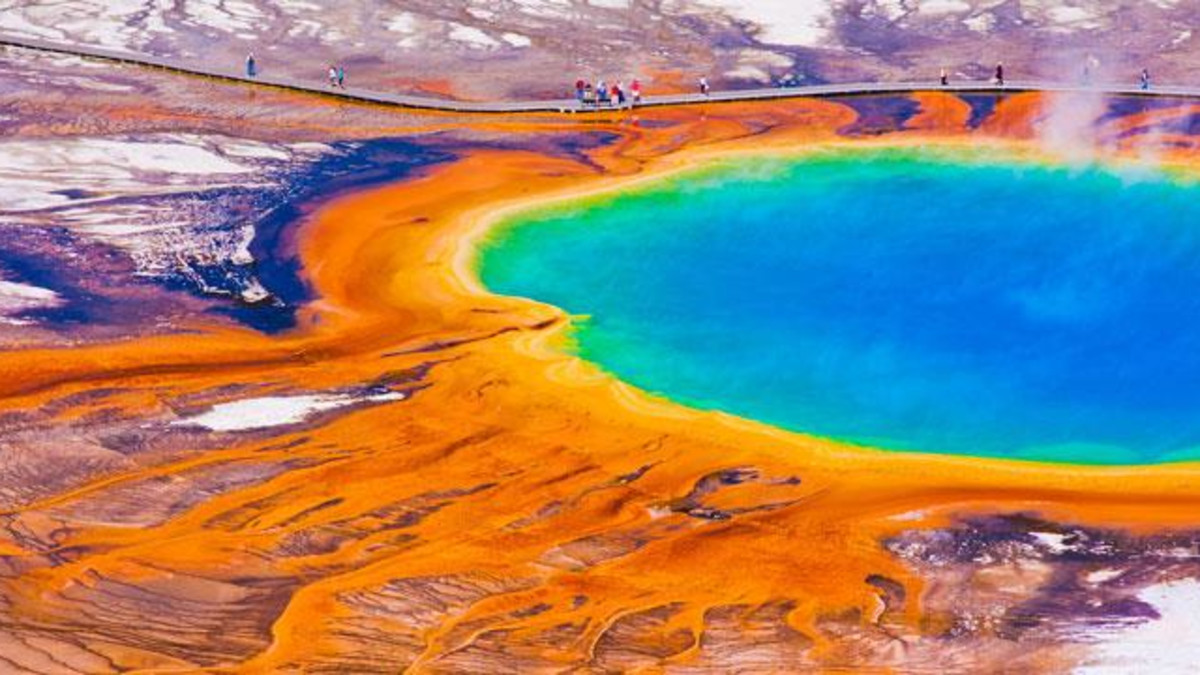
Although water comes out of these springs at around 189 degrees Farenheit, amazingly some resilient cyanobacteria have come to call these pools home.
Since nothing else can live in the seething water, these bacteria subsist on the energy from the heat, as well as inorganic chemicals like hydrogen that they draw from the water. Each type of bacteria thrives at a different temperature, and each is a different color, so as the water cools (down to a chilly 131 degrees or so) at the edges of the pools, microbial colonies appear as colorful rings in the water.
The end-result is a beautiful spectral experience that could give the Zhangye hills a run for their money.
Volcanic Lightning
Springs like those seen in Yellowstone display the more placid side of fire, but it can also be extremely violent.
Nowhere is this more true than during certain volcanic eruptions, when not only does boiling rock spew from the bowels of the earth, but electric fire rains from the sky as well.

When a volcano erupts, ash is often hurled into the air in tremendous quantities. The friction between the ash particles, as well as the rapidly ascending column of hot air, creates static electricity on a massive scale. The end result is both savage and spectacular.

Image from: Scienceblogs.com.
For some of the phenomena I’ve covered in this post I’ve felt the need to explain them in detail, but this incredible spectacle simple speaks for itself.

Image from: Scienceblogs.com.

Image from: National Geographic.
Summary
If you’ve read through this whole post, then you’ve probably noticed a common theme among almost every phenomenon I’ve covered: Although earth, water, wind and fire are powerful forces on their own, it is when they combine that the most stunning and beautiful displays occur.
Where water meets air you could get bubbles frozen in time or an ice storm.
Where fire meets water a beautiful spectrum pool or a floating pumice island may grow.
When earth meets air the entire color of the sky could change.
I don’t want to get preachy, but it’s made me think about the variety that’s present in our human landscape as well. Perhaps people are different for a reason–to work together and make the world a more beautiful place.








